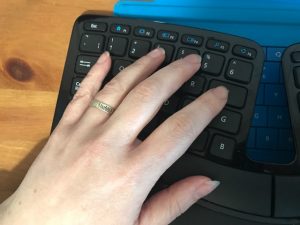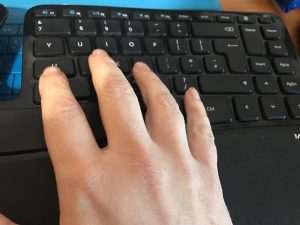
Anyone who has to sit near me in an open office for any length of time usually comments on the punishment that I tend to give keyboards. I type (both general text and code) very quickly. When my fingernails are in good condition (i.e. I haven’t spent the weekend with power tools) this fast typing can make a sound like heavy hail on a conservatory roof. I’ve worn out keyboards before with one work laptop having to use ascii codes every time I needed to type s, n, j or i1 until a replacement arrived. It’s not that I’m a heavy typer, just that I do a lot of it, especially as a hands on manager over the years, I’ve had to write reports, documentation and code, so I’ve learned to be very, very fast at it.
I have fairly broad shoulders for a girl which results in both of my wrists being angled at 45 degrees from their natural resting position with a traditional keyboard. After a long day of coding this can really cause a problem. When I was typing up my PhD thesis, I got myself an ergonomic keyboard2 and absolutely loved it. I used it for work as well until the PS/2 ports gradually died out. The poor keyboard then sat unused in the technological graveyard with all my other old, working tech that I’ll get around to sorting one day3.
I’ve got two months ahead of me and, along side finally finishing the 3D printer and some more maths assignments, my main objective is writing my book. Or should I say books. At some point I’ll go into the concept in a separate post, but for now I have to write 12 novellas in parallel and am looking at something between 400k and 500k words4. I’ve got a decent office set up at home in which I can concentrate and I love my surface (Pro 3) even though I’m not currently commuting. However, fantastic as the surface keyboard is for typing while travelling, for 8 or more hours stationary, I am starting to feel the pressure in my wrists, so realised that it was time to get the updated ergonomic keyboard.
I chose the Microsoft Sculpt Ergonomic Desktop Keyboard, Mouse and Numeric Pad Set mainly because the price was reasonable and it was on Prime from Amazon and it would stop me procrastinating about writing.
The keyboard arrived next day and was efficiently packed. There was the keyboard itself, with an optional riser, a separate keypad and the mouse. The wireless USB connecter was very sensibly stored inside the mouse. The quick start instructions show this so don’t waste your time hunting through the box for it. I am one of those people that tend to RTFM first 😉
All three components come with batteries pre-installed and a plastic tab to remove to complete the connection. While Windows did say it was installing the devices, as soon as I’d inserted the USB into the surface, the keyboard and mouse were responsive.

Firstly the keyboard itself. For me, it’s probably 5 degrees away from perfect comfort when I rest my hands naturally. There is a gap in the middle that is just style and the wrist rest has a slight give to it, but not enough for it to feel soft. I’ve tried it with and without the riser and am currently using it with, probably due to the relative position of my desk with my chair at optimal height. The riser also means I can slide the keyboard over the surface keyboard to keep the desk neat (I don’t want to hide the surface keyboard as I take it out and about with me.
The split space bar makes it easy to use without overstretching a thumb and I’m pleased that the enter key is a double height key just as on a regular keyboard. One irritation is that the windows key is only on the left so I have to use both hands to do the windows-L lock, which I normally manage one-handed as I’m turning away from my desk5. There’s also a switch to lock the function keys on or off – very useful for switching quickly between Windows and coding environment use.

What does let the keyboard down is that your right hand can get lost in a sea of keys. There is (as you’d expect) a small ridge on ‘J’ to help you locate this without a visual check, but with the extra two rows of keys it’s difficult to find the arrow keys and I’ve often hit left when I intended to hit down. For me this isn’t a big deal as I don’t use these when I’m writing, and I code in vi so tend to use other commands to jump around. If I wanted to find them touch typing then I’d either add a small glue dot to ‘down’ or just use my little finger to locate the edge of the keyboard and come in from there. An alternate solution is to use the arrow keys on the numeric keypad, with num lock turned off. If you use these keys a lot you may want to consider this and whether the alternate solutions would work for you.
The second drawback is that there is no indication if you’ve accidentally put caps lock on. There’s no LED for this (or num lock on the numeric keypad for that matter). A lot of reviewers really marked down the keyboard for this and I don’t see why. I’m not looking at the keyboard when I type so I realise I’ve accidentally hit caps lock by what’s showing up on screen not an indicator on a keyboard. Windows helpfully lets you know if caps lock is on when you try to enter your password as well. Sometimes, I code while looking at my notes and not at the screen or the keyboard. In which case an indicator wouldn’t help either. I really don’t feel this is a big deal. However, again something to be aware of.
The keypad feels a bit redundant if you’ve been used to a laptop keyboard, but it’s a great extra. I find I’m using this for PIN access to windows and also with my OU Maths, when I need to do fast numerical entry I switch to left hand numeric pad and right hand mouse as this is how they are on my desk. I know generally number pads are on the right but I find myself far more efficient this way.
The mouse is designed for the right hand, so if you prefer a left handed mouse then this is not for you. The main two buttons are slightly offset from the centre with a track wheel, which feels a little unnatural if you’re used to a normal mouse, but it’s a much better position. The thumb rests naturally in an indentation which has its own button and a windows button. It works pretty well even directly onto a badly scratched wooden desk. I really love the fact that the USB adapter sits in a compartment in the mouse as these little dongles annoyingly tend to get lost. With my surface, this means I can keep it somewhere safe while I take the surface on the train6.
From a functional point of view, the keyboard and mouse are fantastic, they work seamlessly with Windows 10. If you’re not a Windows user you may want to consider other options, but Microsoft have done a great job with this keyboard. I’d love something a little more angled, but I’m likely to be unusual in that regard.
There are some reviews that comment that the dongle doesn’t work well in a USB hub (I will try this out at some point) and also that after about ‘1 year of use’7 the wrist rest ripples and becomes uncomfortable and the keys can stop working, possibly due to dirt behind them. Since I’m going to be a heavy user for the next few months, if I have any problems I will post an update. But for now, I can definitely recommend this.
- Seriously, it was taking so long to get a replacement I got just as fast with alt-1-1-0 so it didn’t interrupt my flow… ↩
- A Microsoft PS/2 natural elite ↩
- Or possibly it’s already been thrown out, I probably wouldn’t know ↩
- I don’t do things because they’re easy 😉 ↩
- Every second is precious and most likely my other hand already has an empty mug in it that needs refilling else why would I be getting up?! ↩
- If I leave the dongle just on the desk I expect one of the kittens will hide it, I’ve found all sorts of things that they’ve claimed over the past few weeks and they do seem to like small USB sized objects… ↩
- This isn’t defined as heavy or light use so it’s hard to judge ↩